As the healthcare industry expands, the demand for diagnostic medical sonographers grows, making it a promising field for those interested in medicine and technology. Using specialized imaging equipment to capture internal body images, sonographers play a crucial role in patient diagnosis. Pursuing a career in sonography requires a blend of theoretical knowledge, practical training, and certification to ensure expertise in this field.
Read on to learn this guide to becoming a sonographer.
Understanding the Role of a Sonographer
Before diving into training and educational requirements, it’s essential to understand the role of a diagnostic medical sonographer. Sonographers use ultrasound equipment to capture real-time images of patients’ internal organs, tissues, and blood flow. These images assist doctors in diagnosing medical conditions ranging from cardiovascular diseases to prenatal conditions.
Beyond technical skills, sonographers must have strong communication skills to explain procedures, reassure patients, and work effectively with medical teams. This career requires precision, as even the smallest imaging error can impact diagnosis and treatment.
Therefore, for anyone aiming to start a career in sonography, selecting the right educational path is critical. There are many courses and training available to get started with this career. This course is a great option , for instance, for those seeking a comprehensive introduction to sonography, providing the foundational knowledge and technical skills needed to excel in this profession.
Prerequisites for Sonography Programs
Most sonography programs require students to meet specific prerequisites, which vary by institution. Commonly, some prerequisites include:
- High School Diploma or Equivalent: A high school diploma or GED is typically required to begin formal sonography training.
- Courses in Math and Science: Basic knowledge in subjects like biology, physics, and mathematics is essential, as these form the foundation of sonographic imaging principles.
- Healthcare Experience: Some programs prefer applicants with prior healthcare experience, such as working as a medical assistant or a nursing aide.
Completing these prerequisites ensures that students are prepared for the technical and scientific coursework involved in sonography training.
Types of Sonography Programs
Sonography education pathways vary, which allows prospective sonographers to choose programs that suit their academic backgrounds and career goals. The main types of sonography programs include:
Associate Degree Programs
An associate degree in diagnostic medical sonography is one of the most common pathways into the field. These programs typically last about two years and include classroom instruction and clinical training. Coursework usually covers anatomy, patient care, ultrasound physics, and specialized areas such as vascular sonography.
Bachelor’s Degree Programs
For those interested in more advanced knowledge, bachelor’s degree programs can provide comprehensive training in sonography and related fields. Bachelor’s programs typically take four years to complete and cover more advanced imaging techniques and medical terminology. Graduates with bachelor’s degrees may also have greater career opportunities, including management or specialized sonography roles.
Certificate Programs
Certificate programs are generally designed for individuals who already hold an associate or bachelor’s degree in a related healthcare field. These accelerated programs focus exclusively on sonography and take about 12 to 18 months to complete. Certificate programs also allow healthcare professionals to specialize in sonography without committing to a full degree.
Core Sonography Courses and Topics

Regardless of the program type, core sonography courses are essential to developing the technical and clinical skills needed for this career. Some key courses include:
- Anatomy and Physiology: This provides an in-depth understanding of the human body, covering major systems such as cardiovascular, musculoskeletal, and reproductive.
- Ultrasound Physics: This covers the principles of sound waves and their interaction with different body tissues, which is essential for understanding image quality and accuracy.
- Patient Care and Safety: This course teaches students how to interact effectively with patients and ensure their safety during imaging procedures.
- Medical Ethics and Law: This course provides essential knowledge on patient confidentiality, medical ethics, and legal considerations in diagnostic imaging.
Some programs also offer advanced coursework in specialized areas, such as vascular sonography or obstetric and gynecological imaging, which benefit those planning to specialize.
Clinical Training and Hands-On Experience
A significant component of sonography training is hands-on experience in a clinical setting. Clinical training allows students to apply their classroom knowledge and develop proficiency in using ultrasound equipment. Most programs include clinical rotations in hospitals or clinics, where students work under the supervision of experienced sonographers.
Also, during clinical training, students practice image acquisition, patient positioning, and report generation, which are critical for a sonographer’s day-to-day responsibilities. Gaining clinical experience can help build confidence and prepare students for real-world challenges they may face after certification.
Continuing Education and Career Advancement
The field of diagnostic medical sonography is continually evolving, with new imaging technologies and techniques emerging regularly. To stay current, sonographers often pursue continuing education, which may be required to maintain certification. Continuing education can include workshops, advanced courses, or professional conferences.
Regarding career advancement, sonographers can also move into leadership roles such as lead sonographer or sonography program director. Some may choose to further specialize or even transition into related fields, such as radiologic technology or medical imaging sales and training.
Conclusion
Becoming a sonographer requires dedication, a solid educational foundation, and hands-on training. By remembering this guide, aspiring sonographers can look forward to a rewarding career that combines technology with patient care. For those committed to advancing in this field, opportunities for specialization and career growth are abundant, making sonography a dynamic and fulfilling choice in healthcare.
















